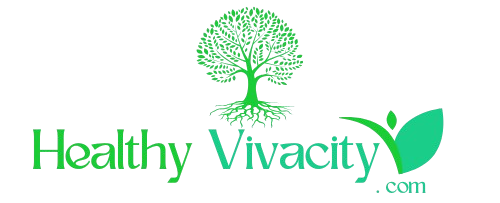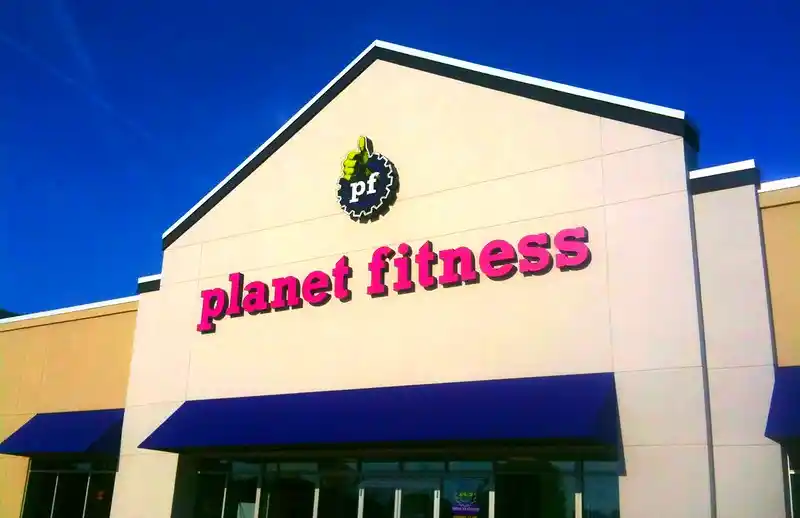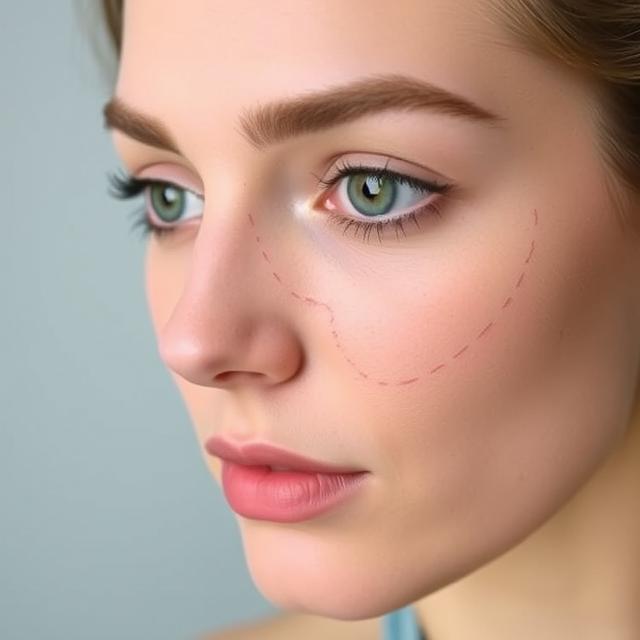
asolabial Fold Filler: Nasolabial folds are common creases in the skin running from each side of the nose to the corners of the mouth; you might know them as “smile lines” or “laugh lines.” Everyone has these lines, but they often deepen with age due to the natural loss of collagen and changes in facial tissue. For many people, these folds can be softened with a dermal filler injection. Hyaluronic acid fillers were used in nearly 4.9 million cosmetic procedures in the U.S. in 2022.
In summary, nasolabial folds are a regular part of aging, and many people use fillers to reduce their appearance in a quick, non-surgical way.
How drug overdose destroys your immune system
Understanding Nasolabial Folds
What Are Nasolabial Folds?
Nasolabial folds are the lines or wrinkles that run from the sides of your nose to the corners of your mouth. They’re so common that everyone has them to some degree. When you’re young, these folds are usually faint, but over time they become more prominent. Aging causes collagen (the skin’s support structure) to break down and facial fat to shift, which makes these lines deeper.
The Cleveland Clinic explains that as we age, our cheekbones can flatten, and gravity pulls the loose skin downward. Additionally, the skin itself has less collagen and elastin to maintain its firmness. Over the years, factors such as sun exposure, smoking, weight fluctuations, and even sleeping on one side can contribute to the accelerated appearance of these folds.
In summary, nasolabial folds (also known as smile lines) naturally develop and deepen with age and certain lifestyle factors. They’re regular facial features, but understanding their cause can help you decide how to treat them.
Cardio vs Strength Training: Which One Is Best for You?
What Causes Nasolabial Folds?
The leading cause of nasolabial folds is aging. Over time, your skin produces less collagen and elastin, resulting in a thinner and less elastic appearance. Additionally, facial fat and bone structures change: cheek fat can diminish, and cheekbones may flatten, causing skin to sag slightly. Gravity also gently pulls down the skin over the years.
Besides aging, environmental and lifestyle factors play a role. Chronic sun exposure breaks down collagen in the skin, making wrinkles more noticeable. Smoking and pollution can have similar effects. Things like significant weight loss or even sleeping on your face can worsen the folds.
In summary, smile lines are mainly due to natural aging (less collagen, sagging skin) combined with other factors like sun damage and lifestyle. These lines tend to deepen over the years, making treatments attractive to many.
How Nasolabial Fold Fillers Work
What Is a Dermal Filler?
A nasolabial fold filler is a type of dermal filler – essentially a soft gel injected under the skin to “fill in” a wrinkle. Its job is to plump up the skin in that area so the fold looks much smoother. Healthline describes dermal fillers as injectable compounds that make fine lines and deep wrinkles appear smoother by plumping the area.
Most dermal fillers used for smile lines are made of hyaluronic acid (HA), a natural substance already found in your skin. When injected, HA attracts water and adds volume under the skin. The result is immediate plumping of the line. All fillers also encourage collagen production over time, which helps keep the area looking fresher even as the gel slowly dissolves.
In summary, fillers are gel-like injections (usually composed of hyaluronic acid) that instantly add volume beneath the nasolabial folds. They smooth out smile lines and boost collagen in the treated area.
Types of Fillers
Hyaluronic acid (HA) fillers are the most popular for nasolabial folds. HA is naturally occurring in the skin, making it highly biocompatible. HA fillers have a gel consistency and come in different thicknesses; your injector will select one suited to the depth of your fold. One great advantage of HA fillers is that they can be dissolved if needed, providing some flexibility.
There are other filler categories as well. Some fillers contain substances like calcium hydroxyapatite or poly-L-lactic acid (PLLA). These work a bit differently: instead of relying solely on the gel’s volume, they stimulate your body to make new collagen in the area over time. These collagen-stimulating fillers often last a bit longer, but they are not as easily reversible as hyaluronic acid (HA).
In Summary, hyaluronic acid fillers are the leading choice for smile lines, offering immediate results and reversibility. Other fillers (calcium or PLLA) are also used for longer-term collagen boosts.
The Nasolabial Fold Filler Procedure
Before the Procedure
Before your injection, you’ll have a consultation with the provider. They will review your medical history and discuss what you’re hoping to achieve. You’ll want to tell them about any allergies, medications (especially blood thinners like aspirin), or skin conditions. They may ask you to stop certain medications or supplements a day or two beforehand to reduce bruising.
On the day of treatment, your skin will be cleaned. Many providers apply a topical numbing cream or ice to the area to minimize pain. Since the treatment is outpatient, you won’t need any special preparation beyond avoiding blood thinners.
In summary, preparing for filler usually involves a quick health check and some skin cleansing and numbing. You’ll be set for the injection session.
During the Injection
Most of the time, you’ll be fully awake during a filler procedure. The injector uses an excellent needle (or sometimes a blunt cannula) and makes a few small injections along the fold. The process itself is fast – often just a few minutes for the injections. Many patients see an improvement right away.
During the injections, your doctor may massage the filler into place and smooth it out. According to the Cleveland Clinic, doctors will gently mold the filler to ensure even distribution and symmetrical features. They’ll keep checking to make sure both sides match.
In Summary, the filler session is quick, and you’ll often notice the fold smoothing out immediately.
Aftercare and Recovery
After you’re done, you might notice some swelling, redness, or mild bruising at the injection sites. This is normal and usually peaks within a day or two. You can use ice packs and gentle massage (if advised) to ease any swelling. These minor effects generally fade within a few days.
One significant advantage of fillers is that there is minimal downtime. You can usually go home or even return to work the same day. Many patients feel well enough to continue normal activities almost immediately. You should avoid heavy exercise and alcohol for approximately 24 hours to minimize swelling. It’s also wise to protect the area from intense sunlight and avoid touching or applying pressure to the face for a short time.
In summary, recovery is straightforward: any mild swelling or bruising should subside within a few days, allowing you to return to your normal activities almost immediately.
Benefits of Nasolabial Fold Fillers
Dermal fillers offer several benefits for treating smile lines. First, they’re non-surgical. That means no incisions, no stitches, and typically, no general anesthesia is required. The results are immediate – you see the line fill in as soon as the gel is injected. Many people are amazed to see a younger-looking profile right after treatment.
Second, fillers add natural-looking volume. By boosting the skin’s collagen, they not only smooth out existing wrinkles but also improve skin texture over time. Dermatologists note that fillers provide a gentle “lift” to the area, plumping up hollows and making the skin appear smoother and softer.
Another advantage is customization and reversibility (for HA fillers). Your doctor can control exactly where and how much filler is used, which means results can be tailored to you. If needed, a hyaluronic acid filler can be partially reversed. Finally, the downtime is minimal. You typically experience some redness or bruising for a short time and can enjoy your fuller smile lines almost immediately.
In Summary, the benefits of fillers include a quick, visible improvement in deep lines with very little recovery time.
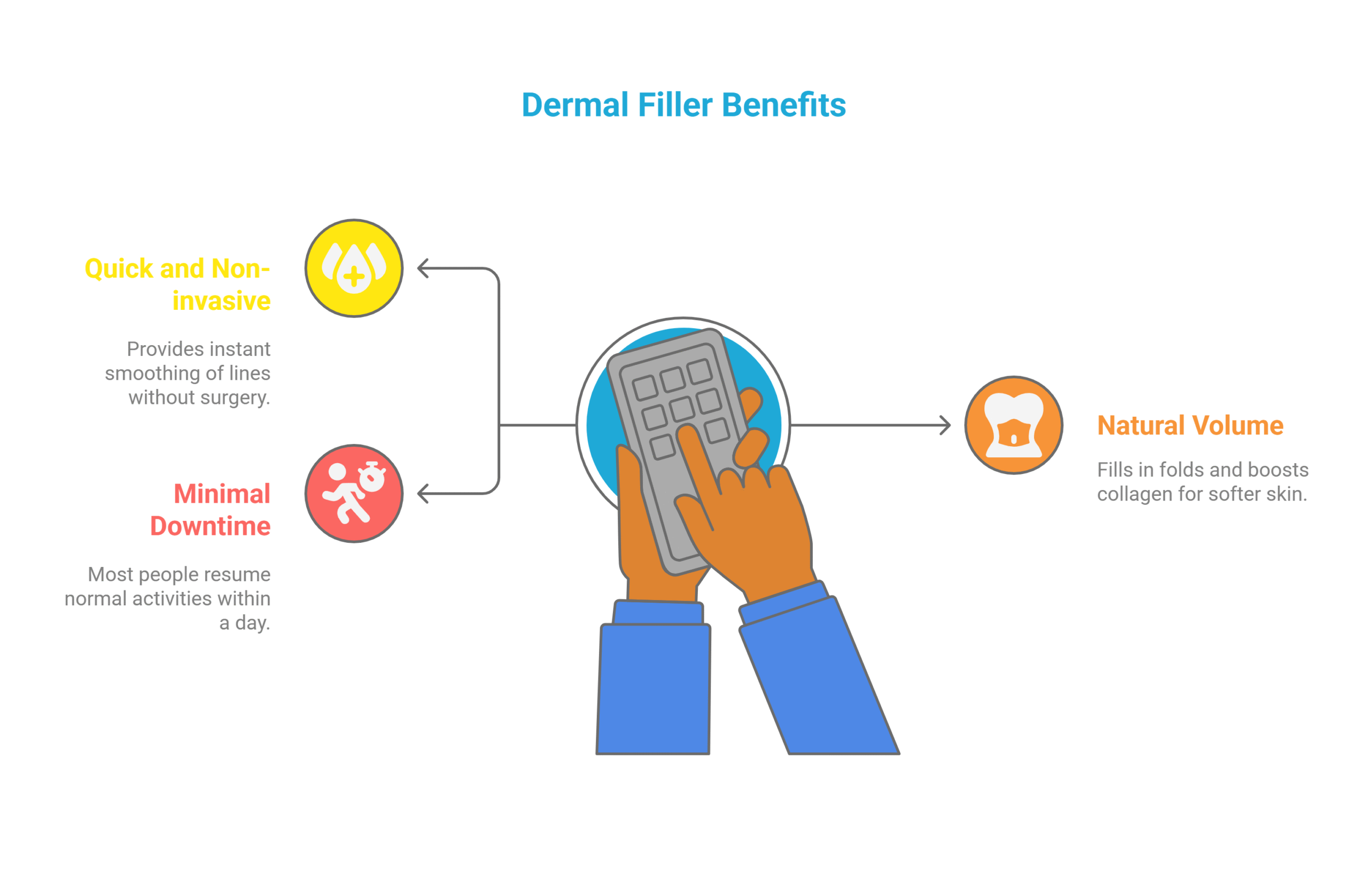
Summary of Benefits:
- Quick and Non-invasive: Instant smoothing of lines without surgery.
- Natural Volume: Fills in the fold and boosts collagen for smoother, softer skin.
- Minimal Downtime: Most people resume normal activities within a day.
In summary, nasolabial fold fillers quickly soften deep lines and add volume where needed, providing a more youthful appearance without significant downtime.
Risks and Side Effects
Like any medical procedure, fillers have potential side effects. The good news is that most are minor and temporary. Common side effects include redness, swelling, bruising, and tenderness at the injection sites. For example, you might appear slightly puffy or bruised, similar to how you look after a challenging workout. These effects typically resolve on their own within a few days.
Less commonly, people can develop small lumps or bumps under the skin. Usually, these are harmless and can be massaged out by your provider. Infection at the injection site or an allergic reaction is very uncommon, mainly if your injector follows proper hygiene practices.
According to the FDA, the most serious risk is the accidental injection of the filler into a blood vessel. This can block blood flow and potentially cause tissue damage (necrosis) or, in extreme cases, affect the eyes or nerves. Fortunately, this is very unusual, especially with experienced providers, but it’s one reason to choose a qualified professional.
In summary, most side effects are mild (such as swelling and bruising) and short-lived. Serious complications are infrequent, but it is essential to follow aftercare instructions and contact your provider if you notice anything unusual.
Cost of Nasolabial Fold Fillers
Nasolabial Fold Filler: Cost varies widely, but dermal fillers are typically priced by syringe. On average, you can expect anywhere from about $500 to $900 (or more) per syringe of filler, depending on the type of filler and where you live. For instance, a 2019 estimate listed the cost of hyaluronic acid filler at around $652 per syringe. Many people need at least one or two syringes to noticeably soften deep folds, so you’ll want to budget accordingly.
Keep in mind that fillers are considered a cosmetic treatment, so insurance typically does not cover them. However, some clinics offer package deals, membership plans, or special promotions. It’s smart to ask about any discounts or payment plans when you consult with your provider.
In summary, filler treatments have a cost that reflects the product and skill involved. Be sure to discuss pricing and the number of syringes you may need in advance.
Alternatives to Fillers
Fillers are a great quick option, but they aren’t the only way to reduce smile lines. If you’re looking for alternatives, options range from non-invasive to surgical:
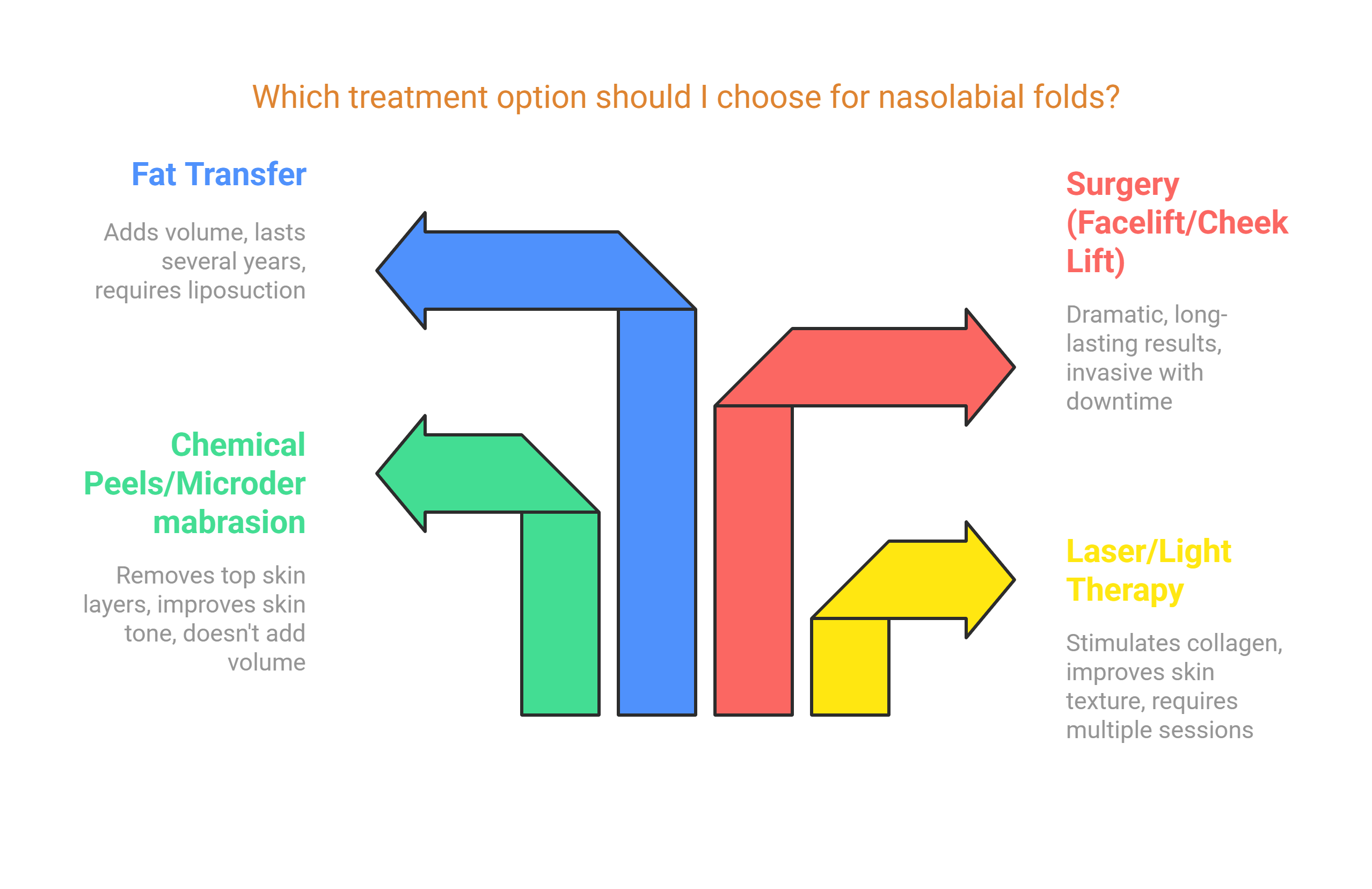
- Laser or light therapies: Treatments such as laser resurfacing or radiofrequency can stimulate collagen, gradually improving skin tightness and texture. They can soften lines over time but usually take multiple sessions.
- Chemical peels and microdermabrasion: These treatments remove the top layers of skin to reveal fresher, healthier-looking skin. They help fine wrinkles and overall skin tone but won’t add volume to deep folds.
- Surgery (facelift/cheek lift): For the most dramatic and long-lasting results, a surgical facelift or cheek lift repositions the skin and tissue. This is a more invasive option, with increased downtime and cost. Still, it can substantially reduce the appearance of nasolabial folds.
- Fat transfer: A plastic surgeon can remove fat from one part of your body and inject it into the cheeks or nasolabial area. This procedure adds real tissue (fat) to plump the fold, which can last several years. However, it is a more extensive procedure (liposuction is required), and the results can be less predictable.
In summary, besides fillers, you can consider lasers, peels, or even surgery for smile lines. Each has its risks, benefits, and recovery time. Consulting a specialist can help you pick the best option for your goals.
Choosing the Right Provider
Nasolabial Fold Filler: Who injects your filler is just as important as the type of filler used. To ensure a safe and happy outcome, choose a qualified and experienced professional. Board-certified dermatologists and plastic surgeons are the gold standard for these injections. The FDA advises working with a licensed healthcare provider who is experienced in injectables.
Avoid being tempted by bargain deals at non-medical spas or “medusas” that lack proper credentials. Always verify credentials. During the consultation, ask to see before-and-after photos of the doctor’s actual patients. A knowledgeable provider will clearly explain the procedure, discuss potential side effects, and ensure you have realistic expectations. They should listen to your concerns and tailor the treatment to your face.
In Summary, careful selection of providers is key. A skilled, certified injector will maximize safety and give you natural-looking results.
Summary of Key Points
Nasolabial Fold Filler: To recap, nasolabial folds (smile lines) are a regular part of aging that deepen as collagen and tissue diminish. Dermal fillers (usually hyaluronic acid gel) are injected to plump and smooth these lines. Results are visible immediately and typically last between 6 and 18 months. Most side effects (like mild bruising or swelling) are temporary and resolve in days. Finally, protecting your skin with daily sunscreen and choosing a skilled provider will help ensure safe, long-lasting, natural-looking results.
Frequently Asked Questions
A nasolabial fold filler is a soft gel (usually hyaluronic acid) that is injected under the skin of the smile line to add volume and smooth the wrinkle. It acts like a cushion, lifting the skin in that crease so the line looks less deep. You’ll see an immediate effect: the fold becomes less noticeable right after the injection.
Anyone with visible nasolabial folds who wants a quick improvement could be a candidate. Generally, healthy adults of most ages are eligible. Your doctor will review any medical conditions you have; for example, if you have an active skin infection (like a cold sore) or a bleeding disorder, they may ask you to wait. Also, if you are pregnant or breastfeeding, it’s usually best to postpone since safety during pregnancy isn’t well-studied.
Most people feel only a brief pinch or pressure. Before injecting, the provider typically cleans and numbs your skin with a cream or ice. Many modern fillers also contain a numbing agent. During the injection, you may feel slight discomfort or a brief sting, but this is a temporary sensation. The Cleveland Clinic notes that doctors use ice or numbing gel to keep patients comfortable during procedures.
Results are temporary. Most hyaluronic acid fillers used in the cheek and nasolabial area last between 6 and 18 months. The exact duration depends on the product used, the rate at which your body breaks down the filler, and the area being treated. For example, fillers in a highly mobile area may fade more quickly.
